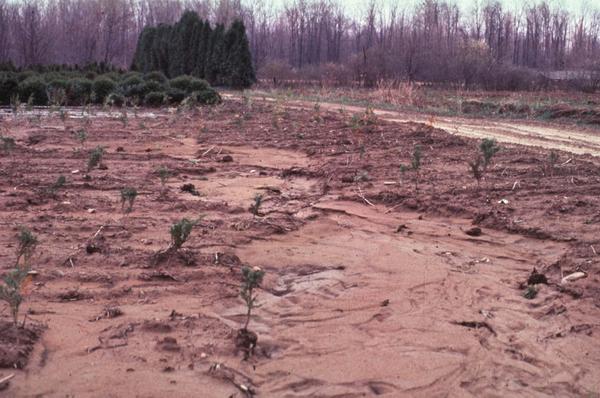You Will Have Questions
Immediately after a flood, most farmers, nursery crops producers and grounds maintenance staff have much more urgent matters to worry about than weeds. But, eventually the questions arise:
- Has my preemergence herbicide washed away compromising control at the intended site?
- How do I know?
- Should I re-treat? If so, what should I consider?
- What’s going to happen now?
Unfortunately there is no single, economical way to provide definitive answers to these questions. But here are some tips and suggestions that will help you plan a response.
Have My Preemergence Herbicides Washed Away?
The short answer is yes – at least some of it. Residual herbicides bind to the soil colloids and organic matter, so if the soil has eroded, it is safe to assume that the herbicides are gone.
Some herbicides can be washed away or leached even if there is little soil erosion with excessive rainfall events. Additionally, some herbicides may degrade more rapidly in saturated soils. For example: dinitroanaline herbicides (trifluralin, prodiamine, oryzalin, pendimethalin) degrade more rapidly in saturated soils than in well drained soils. The half-life may be as short at five days in warm, wet (anaerobic) soils compared to 45 – 60 days in aerobic soils. The rates of degradation will be different for each herbicide and may be affected by temperature, soil pH, organic matter content, soil type and texture, and by how long the soil is saturated.
Preemergent herbicide movement potential increases as:
- Soil texture coarseness increases (i.e. increasing sand content)
- Soil organic matter decreases
- Slope increases
- Vegetative cover decreases (more bare soil = more movement)
What herbicide(s) were applied?
- Most notable properties pertain to soil/organic matter binding affinity and water solubility.
- Herbicides with lower binding affinities are more prone to move from the intended site.
- General binding affinity ranking for common PRE’s is (from least to highest):
Simazine < Indaziflam < Dithiopyr < Oxadiazon < dinitroanalines
- Herbicides with higher water solubility are more prone to move from the intended site.
Simazine > Indaziflam > Dinitroanalines
How much time lapsed between application and excessive rainfall?
This is not so much from a calendar day-count perspective, but the number of soil wet-dry cycles. The more cycles that occur between preemergent application and excessive rainfall, the more likely the herbicide is to be bound to the soil, which should reduce its potential to move laterally or downward via water flow.
How long the soil or substrate is saturated?
Some herbicides degrade more rapidly in saturated soils. Below are estimates of persistence for common nursery and landscape herbicides in saturated soils: Dinitroanalines < flumioxazin < simazine < oxadiazon < sulfonylureas
How Do You Know if Your Herbicide Is Gone?
One way to find out is to conduct a bioassay. A bioassay is a simple and inexpensive way to determine if herbicide residues are present at high enough concentrations to affect seedling emergence or plant growth. A factsheet with guidelines for conducting a bioassay is available: Conducting a Bioassay For Herbicide Residues.
Should I Re-Apply Herbicide(s)?
It is generally safe to assume that at least some of your residual herbicides have either moved off-target or degraded after an excessive rainfall event. So, it is generally a safe assumption that you will need to re-apply herbicides. Because some of the herbicide likely remains in the soil, we advise rotating to a different mode of action. For example; if your residual herbicide application was a combination of simazine and oryzalin, we would advise rotating to flumioxazin or indaziflam. Information about herbicide modes of action is available in the weed control sections of the North Carolina Agricultural Chemicals Manual. Alternatively, if rotation to a different mode of action is not feasible (due to crop safety or other concerns), then apply the lowest labeled dose of the herbicide.
What’s Going to Happen Now?
Weeds will be emerging. Floodwaters will also carry and deposit weed seeds. Eroded soil washed into your fields will carry weed seeds – and those weed seeds don’t mind being submerged. Constant soil moisture during the storm and after will result in rapid weed seed germination and establishment. So be prepared to control emerged weeds with postemergence herbicides. Seedlings can be controlled with contact-type herbicides (such as diquat, gramoxone or glufosinate). If treatments are delayed (because you are likely busy with other important things), a systemic herbicide (such as glyphosate) may work better. Combining postemergence with preemergence herbicides will improve weed control and will be more time-efficient.
While you are busy with other tasks, weeds can grow rapidly. Try to control weeds before they go to seed. This will prevent future generations of weeds.
If you had a relatively weed-free site before the flood, the increased weed seed load that comes with flood waters and silt will require a more aggressive weed management program next year. Depending on the species of weeds introduced, last year’s weed control program may not be as effective. Plan to scout fields for new weeds and control them before they can spread. Be ready to adjust mid-season treatments as weeds emerge.
Publication date: Oct. 13, 2016
N.C. Cooperative Extension prohibits discrimination and harassment regardless of age, color, disability, family and marital status, gender identity, national origin, political beliefs, race, religion, sex (including pregnancy), sexual orientation and veteran status.

